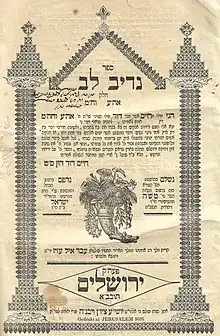Chaim David Hazan | |
|---|---|
חיים דוד חזן | |
 A posthumous 1926 edition of one of his books, "Benevolent" | |
| Born | 1790 |
| Died | January 17, 1869 (aged 78/79) Jerusalem, Ottoman Empire |
| Spouse | Joya Esther |
| Parent |
|
| Relatives | Eliezer Hazan (brother) Rachmim Eliyahu Hazan (brother) Haim Palachi (nephew) Eliyahu Bechor Hazan (grandson) |
Chaim David Hazan (Hebrew: חיים דוד חזן; 1790 – January 17, 1869) nicknamed Chabad Badara (Hebrew: ח"ד בדרא) was an Av Beit Din in İzmir, rabbinical scholar, and Rishon LeZion of Israel.
Early life and formative years
Born in İzmir to Sephardic Rabbi Raphael Yosef Hazan, son of Chaim, and Reina Falaji, Hazan learned the profession of shochet from a young age. His father was a chief rabbi in the city and considered a great sage of the 19th century. By the time he had grown into adulthood, he was chosen as the head of the shochets in the area. By 1840, he was appointed to a head position in the city's rabbi community, a position he held until 1855.[1]
Emigration to Israel and career
In 1855, he immigrated to Eretz Yisroel and settled in Jerusalem, where he was appointed to the Beit Din alongside Moshe Benvenisti, Yitzhak Cordoviro, Yitzhak Kalmaro, and Avraham Amar.[2] In 1859, he went on a mission with five other rabbis from Jerusalem to Vienna, but he fell ill and returned home.[3] In 1861, Rabbi Chaim Nissim Abulafia passed away, and Hazan was elected to take his place in the rabbinate as the Chief Sephardi Rabbi in Israel, as well as Hakham Bashi of Jerusalem, and the two roles were united for the region with his election. He worked extensively for the agricultural settlements in the land, and he worked in close proximity with Zvi Hirsch Kalischer, to which the two decided on planting willow trees in the settlement of Kfar Hashiloah.[3] He also played an active role in the development of the Batei Mahse complex.
In 1863, a large assembly was held in Jerusalem at the initiative of Hazan, Chaim Tzvi Schneerson, and other dignitaries from the community with the aim of examining how many emigrants of the Old Yishuv were willing to switch to agricultural work to develop settlements in the region. The assembly decided, among other things, that it was necessary to obtain a license from the government to purchase land for cultivation, and that a three-year support system should be established before the beginning of the project. Following the meeting, around 100 families announced their desire to work as farmers on the land, and the project was headed by Hazan, Schneerson, and Benvenisti. The initiative never came to fruition due to deteriorating relations between the Jews and the Ottoman government.[4]
He resided in the Mishkenot Sha'ananim neighborhood, the first Jewish settlement outside of the walled limits of the city. When the 1863-1875 cholera pandemic reached Jerusalem in 1865, he moved inside the walls to share in the city's grief.[5] He died on January 17, 1869[6] and is buried at the Mount of Olives Jewish Cemetery.[7]
Family
Hazan was initially married to Joya Esther, daughter of Yisrael Chaim HaCohen Hamzi. She passed away in 1862, and he remarried in his final years to a woman named Sultana. He had an older brother, Rabbi Eliezer Hazan, as well as brothers Rachmim Eliyahu Hazan and Yitzhak Hazan.[6] He had a sister, Kali Kaden, who became the mother of Chaim Falaji. His pedigree is as follows:
- Avraham Hazan (1815–1875), a butcher in Aydin
- Gershon Hazan (died 1870)
- Joshua Hazan (died 1877)
- Raphael Joseph Hazan (1823–1877)
- Rabbi Eliyahu Bechor Hazan, Av Beit Din in Alexandria[8]
- Aharon di Yosef Hazan, writer and editor of Ladino newspapers in İzmir
- Rachel, wife of Rabbi Bechor Chaim Yitzhak Nachum (1834–1896)
- Israel Sheikh Hazan (1835–1896)
- Moshe Hazan
- Sarah (m. Joseph Raphael Uziel)
Selected works
- Hazan, Chaim David. ספר אגן הסהר : והוא פי' על משלי [The Book on the Crescent Basin: Book of Proverbs] (in Hebrew). Thessaloniki.
- Hazan, Chaim David. ספר חוזה דוד : והוא פירוש על תהילים בדרך דרש [Treatise on the Book of David] (in Hebrew). Amsterdam.
- Hazan, Haim David (1844). תורת זבח - שחיטה וטרפות [Slaughter and Predation] (in Hebrew). Thessaloniki.
- Hazan, Hayim David (1862). נדיב לב - חלק א-ב [Benevolent - Volumes I & II] (in Hebrew). Thessaloniki.
{{cite book}}: CS1 maint: location missing publisher (link) - Hazan, Hayim David (1870). ישרי לב [Honest-hearted] (in Hebrew). İzmir.
{{cite book}}: CS1 maint: location missing publisher (link)
References
- ↑ Tidhar, David (1946). Encyclopedia of the Founders and Builders of Israel (in Hebrew). p. 3609. Retrieved 2024-01-03.
- ↑ Westreich, Elimelech (2008). "LEVIRATE MARRIAGE IN THE STATE OF ISRAEL - Tel Aviv University Law School". law.bepress.com. pp. 457–458. Retrieved 2024-01-03.
- 1 2 "חכם חיים דוד חזן : החכם היומי". hyomi.org.il (in Hebrew). Retrieved 2024-01-03.
- ↑ קלויזנר, ישראל (1973). רבי חיים צבי שניאורסון : ממבשרי מדינת ישראל (in Hebrew). p. 41. Retrieved 2024-01-03.
- ↑ "שנה תשיעית גיליון". Hamagid (in Hebrew). No. 49. 1865.
- 1 2 "הראשון לציון רבי חיים דוד חזן". mytzadik.com (in Hebrew). Retrieved 2024-01-03.
- ↑ "כרטיס קבר: חיים דוד חזן » הר הזיתים, ירושלים". הר הזיתים, ירושלים (in Hebrew). Retrieved 2024-01-03.
- ↑ "בחירת הורים בחינוך: מי יכול לבחור? | Sefaria". sefaria.org (in Hebrew). Retrieved 2024-01-03.
External links
- Haim David Hazan at the National Library of Israel